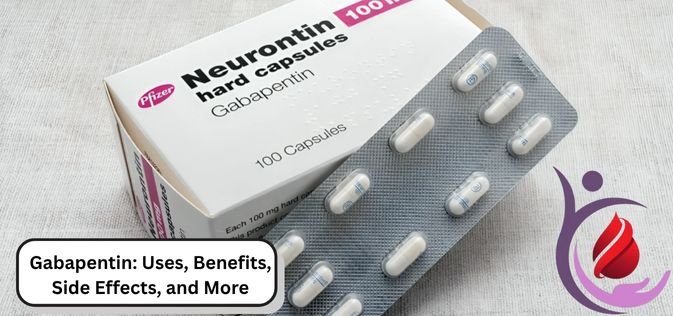Gabapentin: Uses, Benefits, Side Effects, and More
Gabapentin a commonly prescribed medication primarily used to treat nerve-related conditions. It belongs to a class of drugs known as anticonvulsants or anti-epileptic drugs. Initially developed to treat epilepsy, Gaba pentin has shown effectiveness in managing various other medical conditions such as neuropathic pain, restless legs syndrome, and hot flashes. With its widespread use, it’s important to understand how Gaba pentin works, its applications, potential side effects, and precautions.
What Is Gabapentin?
Gabapentin is a synthetic compound that resembles the neurotransmitter gamma-aminobutyric acid (GABA), although it does not act directly on GABA receptors. It alters the way nerves send messages to the brain and is effective in calming abnormal nerve activity. Gaba pentin is available under various brand names, including Neurontin, Gralise, and Horizant.
It is typically available in the form of capsules, tablets, and oral solutions. Dosages vary depending on the medical condition treated.
Common Uses of Gabapentin
Gabapentin prescribed for several conditions. Some of the most common include:
1. Epilepsy
Its originally approved as an adjunct treatment for partial seizures in epilepsy patients. It often used in combination with other anti-epileptic medications.
2. Neuropathic Pain
Its widely used for the treatment of chronic nerve pain caused by:
- Diabetic neuropathy
- Postherpetic neuralgia (shingles-related nerve pain)
- Sciatica
- Peripheral neuropathy
Its effectiveness in managing nerve-related pain has made it a preferred treatment option in these conditions.
3. Restless Legs Syndrome (RLS)
Gaba pentin enacarbil (a prodrug of Gabapentin) is FDA-approved for treating moderate to severe restless legs syndrome.
4. Anxiety Disorders
Although not FDA-approved for this use, some doctors prescribe Gaba pentin off-label to manage symptoms of anxiety, particularly in generalized anxiety disorder (GAD) or social anxiety.
5. Fibromyalgia
Gaba pentin is sometimes used off-label for fibromyalgia, a chronic condition characterized by widespread muscle pain and fatigue.
6. Hot Flashes
Gaba pentin may also be used as an alternative treatment for menopausal hot flashes, particularly when hormone replacement therapy is not suitable.
How Gabapentin Works
Gaba pentin binds to the alpha-2-delta subunit of voltage-gated calcium channels in the central nervous system. This binding reduces the release of excitatory neurotransmitters, thereby calming overactive nerve signals. Although it mimics the structure of GABA, it doesn’t directly influence GABA activity.
Dosage and Administration
Gabapentin dosage depends on the condition being treated, age, and response to therapy. Typically, the treatment starts with a low dose that is gradually increased.
- For epilepsy: Starting dose might be 300 mg once a day, increasing to 300 mg three times a day.
- For nerve pain: Initial dose often starts at 300 mg at bedtime, with gradual titration up to 1800–3600 mg per day.
- For RLS or hot flashes: Dosage and timing may vary.
Gaba pentin should be taken exactly as prescribed. Abrupt discontinuation can lead to withdrawal symptoms or worsening of seizures.
Potential Side Effects
Gabapentin is generally well-tolerated but may cause side effects in some individuals. Common side effects include:
- Dizziness
- Fatigue
- Drowsiness
- Swelling in hands or feet (peripheral edema)
- Weight gain
- Blurred vision
- Tremors
- Dry mouth
More serious but less common side effects may include:
- Mood changes (depression, anxiety, suicidal thoughts)
- Difficulty breathing (especially in older adults or those with respiratory issues)
- Allergic reactions (rash, itching, swelling)
Precautions and Warnings
1. Suicidal Thoughts
Gaba pentin carries a warning about the potential for increased risk of suicidal thoughts or behavior. Patients should be monitored for any mood or behavioral changes.
2. Kidney Function
Because Gaba pentin is eliminated via the kidneys, patients with renal impairment require dose adjustments.
3. Substance Use
Although Gaba pentin is not classified as a controlled substance in most countries, misuse and dependency have been reported, especially among those with a history of substance abuse.
4. Drug Interactions
Gabapentin may interact with:
- Antacids containing aluminum or magnesium (reduce absorption of Gabapentin)
- Morphine (increased side effects like sedation)
- Other CNS depressants (risk of increased drowsiness or respiratory depression)
Always inform your doctor about any other medications, supplements, or herbal products you are taking.
Use in Special Populations
1. Pregnancy and Breastfeeding
Gaba pentin should be used during pregnancy only if clearly needed. It is excreted in breast milk, so caution is advised when nursing.
2. Elderly
Older adults may be more sensitive to side effects such as drowsiness and dizziness. Dose adjustments are often necessary.
3. Children
Gaba pentin is approved for use in children over 3 years old for seizures but should be used under close medical supervision.
Tips for Safe Use
- Take consistently: Stick to the same time every day.
- Don’t crush or chew extended-release tablets.
- Avoid alcohol while on Gaba pentin as it may increase drowsiness.
- Notify your doctor if you experience worsening mood, depression, or thoughts of self-harm.
- Taper gradually: Do not stop Gaba pentin suddenly without consulting a physician.
Alternatives to Gabapentin
If Gabapentin does not work or causes intolerable side effects, alternatives include:
- Pregabalin (Lyrica): Similar mechanism, used for nerve pain and epilepsy.
- Amitriptyline: A tricyclic antidepressant used for neuropathic pain.
- Duloxetine: A serotonin-norepinephrine reuptake inhibitor (SNRI) for nerve pain.
Conclusion
Gabapentin is a versatile and widely used medication with proven effectiveness in treating nerve-related conditions like epilepsy, neuropathic pain, and restless legs syndrome. While it is generally safe, like all medications, it carries risks of side effects and potential misuse. By using Gabapentin responsibly under medical guidance and monitoring, many patients find significant relief and improved quality of life. Always consult your healthcare provider before starting or changing any medication regimen.
Also Read About –

